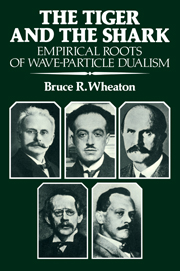Book contents
- Frontmatter
- Contents
- Foreword by Thomas S. Kuhn
- Preface
- Notes on sources
- 1 Introduction
- Part I The introduction of temporal discontinuity, 1896–1905
- Part II Ionization and the recognition of paradox, 1906–1910
- Part III Seeking an electrodynamic solution, 1907–1912
- Part IV Interference of x-rays and the corroboration of paradox, 1912–1922
- Part V The conceptual origins of wave–particle dualism, 1921–1925
- Epilogue: The tiger and the shark
- Bibliography
- Index
1 - Introduction
Published online by Cambridge University Press: 04 August 2010
- Frontmatter
- Contents
- Foreword by Thomas S. Kuhn
- Preface
- Notes on sources
- 1 Introduction
- Part I The introduction of temporal discontinuity, 1896–1905
- Part II Ionization and the recognition of paradox, 1906–1910
- Part III Seeking an electrodynamic solution, 1907–1912
- Part IV Interference of x-rays and the corroboration of paradox, 1912–1922
- Part V The conceptual origins of wave–particle dualism, 1921–1925
- Epilogue: The tiger and the shark
- Bibliography
- Index
Summary
For all practical purposes the wave theory of light is a certainty.
This is the story of a radical change in humans' concept of light. In 1896 most physicists were convinced that light consisted of wave disturbances in a medium, the electromagnetic aether. The energy transported in radiation was thought to propagate spherically outward from its source and to spread out over successively larger volumes in space. Thirty years later, a remarkably different concept of light prevailed. Physicists then took seriously the evidence collected over the preceding two decades showing that the energy of radiation does not spread in space. Under certain conditions, light behaves like a stream of particles.
Our subject is more than the story of a shift from one theoretical explanation of radiation to another. This reconsideration of the nature of light was a significant event in our scientific understanding of the world. To resolve the paradox that faced them, physicists rejected the venerable Platonic dictum that the microscopic realm recapitulates the macroscopic; that laws generalized from the behavior of objects in the perceivable world may be applied to the imperceivable one. By 1927 physicists had assigned to all forms of radiation a curious amalgam of wave and particle behavior. Waves spread energy over larger and larger volumes of space; particles do not. Reconciliation of these conflicting properties was possible only through appeal to an ontology that transcended mechanical incompatibility.
Nature was declared to be only imperfectly rationalizable in terms of human experience with macroscopic interactions. The programmatic goal formulated in the seventeenth century to reduce all physical phenomena to consistent mechanical representations was here recognized to be unattainable.
- Type
- Chapter
- Information
- The Tiger and the SharkEmpirical Roots of Wave-Particle Dualism, pp. 1 - 12Publisher: Cambridge University PressPrint publication year: 1983



